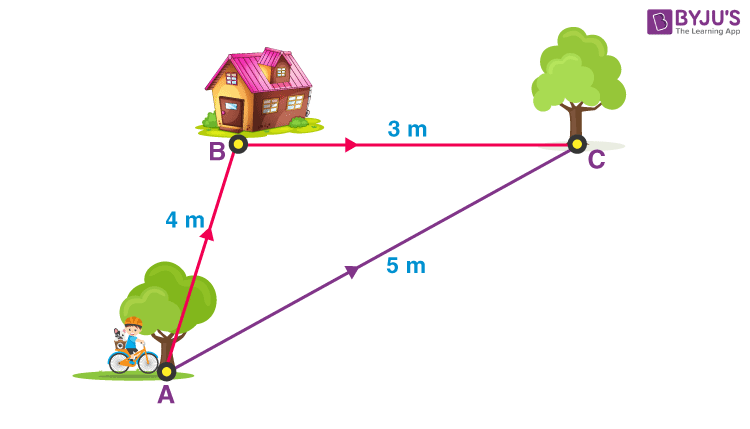Distance and displacement are two quantities that seem to mean the same but are distinctly different with different meanings and definitions. Distance is the measure of “how much ground an object has covered during its motion” while displacement refers to the measure of “how far out of place is an object.” In this article, let us understand the difference between distance and displacement.
What Is Distance?
Distance is the total movement of an object without any regard to direction. We can define distance as to how much ground an object has covered despite its starting or ending point.
Let’s understand the concept of distance with the help of the following diagram:

Explanation of distance
Distance here will be = 4m + 3m + 5m = 12 m
Distance Formula
How is Displacement defined?

Examples of Distance and Displacement
Question 1. John travels 250 miles to North but then back-tracks to South for 105 miles to pick up a friend. What is John’s total displacement?
Answer: John’s starting position Xi= 0.
Her final position Xf is the distance travelled N minus the distance South.
Calculating displacement, i.e.D.
D = ΔX = (Xf – Xi)
D = (250 mi N – 105 mi S) – 0
D = 145 mi N
Question 2. An object moves along the grid through points A, B, C, D, E, and F as shown below. The side of square tiles measures 0.5 km.
a) Calculate the distance covered by the moving object.
b) Find the magnitude of the displacement of the object.

Solution:
a) The distance covered by the moving object is calculated as follows:
AB + BC + CD + DE + EF
3 + 1 + 1.5 + 0.5 + 0.5 = 6.5 km
The distance covered by the moving object is 6.5 km.
b) The initial point is A and the final point is F, hence the magnitude of the displacement is equal to the distance AF which is calculated by applying Pythagoras’s theorem to the triangle AHF as shown in the figure below

Applying the Pythagorean formula, we get
Substituting the formula, we get
The magnitude of displacement is 2.5 km.








0 Comments